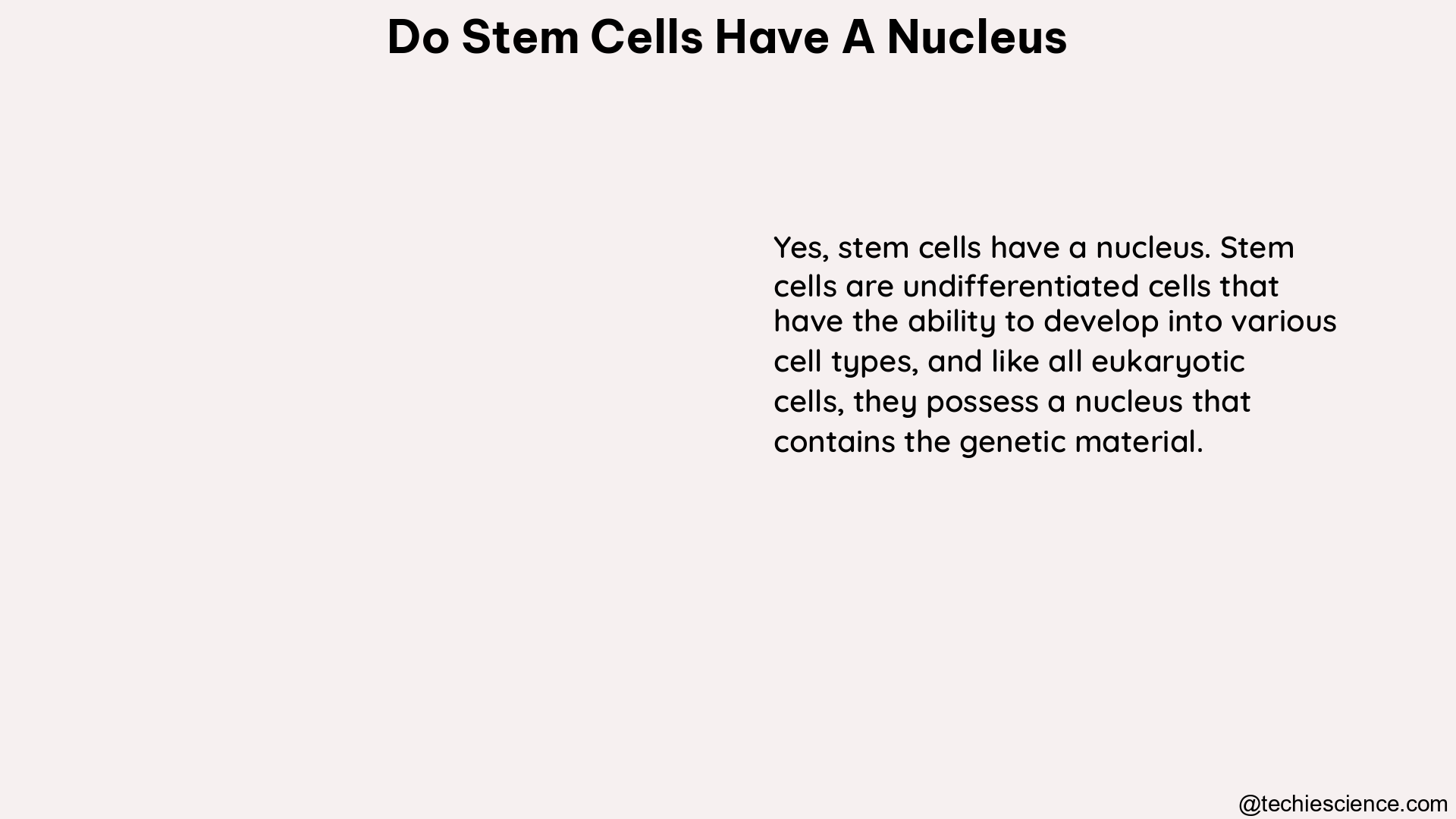Stem cells, like other eukaryotic cells, possess a nucleus that houses their genetic material, which is essential for their growth, development, and reproduction. The nucleus is a membrane-bound organelle that plays a critical role in regulating gene expression and maintaining the undifferentiated state of stem cells.
The Importance of the Nucleus in Stem Cells
The nucleus is the most prominent organelle in a stem cell, and it can be easily identified using various staining techniques. In the context of stem cell biology, the nucleus is a key determinant of the cell’s function, behavior, and differentiation potential.
Regulating Gene Expression and Self-Renewal
Human embryonic stem cells (hESCs) are known to have large nuclei with prominent nucleoli, which are indicative of their high metabolic activity and capacity for self-renewal. The size and morphology of the nucleus can provide insights into the quality and differentiation potential of hESCs. For instance, colonies with larger nuclei and intercellular distances are associated with lower cell density and fewer nearest neighbors, which may affect cell-to-cell interactions and community effects within the colonies.
Influencing Stem Cell Mechanics and Differentiation
The nucleus is also a key determinant of stem cell mechanics and differentiation. Nuclear mechanics is emerging as a critical component of stem cell function, and changes in nuclear structure can influence cell behavior and differentiation. For example, siRNA-mediated Lamin A/C depletion can alter chromatin and Lamin A/C structures, leading to changes in nuclear stiffness and potentially affecting stem cell differentiation.
Structural and Functional Characteristics of the Stem Cell Nucleus

The nucleus of a stem cell is a highly specialized organelle that exhibits unique structural and functional characteristics compared to the nuclei of other cell types.
Nuclear Size and Morphology
The size and morphology of the stem cell nucleus can provide valuable insights into the cell’s state and differentiation potential. Undifferentiated stem cells, such as hESCs, typically have larger nuclei with prominent nucleoli, reflecting their high metabolic activity and capacity for self-renewal.
| Cell Type | Nuclear Size | Nucleoli Prominence |
|---|---|---|
| Undifferentiated hESCs | Larger | More Prominent |
| Differentiated Cells | Smaller | Less Prominent |
As stem cells differentiate, their nuclear size and nucleoli prominence tend to decrease, indicating a shift in their metabolic activity and gene expression profiles.
Chromatin Organization and Epigenetic Regulation
The stem cell nucleus is also characterized by a unique chromatin organization and epigenetic regulation. Undifferentiated stem cells have a more open and accessible chromatin structure, which allows for the expression of genes involved in self-renewal and pluripotency. During differentiation, the chromatin structure becomes more compact, leading to the silencing of pluripotency genes and the activation of lineage-specific genes.
Epigenetic modifications, such as DNA methylation and histone modifications, play a crucial role in regulating gene expression in stem cells. These epigenetic changes are orchestrated by various chromatin-modifying enzymes and transcription factors within the nucleus, which are essential for maintaining the stem cell state and directing differentiation.
Nuclear Mechanics and Stem Cell Behavior
The mechanics of the stem cell nucleus, including its stiffness and deformability, can influence the cell’s behavior and differentiation potential. Changes in nuclear structure, such as alterations in the expression of nuclear lamins or the organization of the cytoskeleton, can affect nuclear mechanics and, consequently, stem cell function.
For example, siRNA-mediated depletion of Lamin A/C, a key structural protein in the nucleus, can lead to changes in chromatin organization and nuclear stiffness, which may impact stem cell differentiation. Understanding the relationship between nuclear mechanics and stem cell behavior is an active area of research, as it may provide insights into the mechanisms underlying stem cell fate decisions.
Techniques for Studying the Stem Cell Nucleus
Researchers employ various techniques to study the structure, function, and dynamics of the stem cell nucleus, including:
- Microscopy Techniques: Confocal microscopy, electron microscopy, and super-resolution microscopy are used to visualize the detailed structure and organization of the stem cell nucleus.
- Biochemical Assays: Techniques like chromatin immunoprecipitation (ChIP), DNA methylation analysis, and histone modification assays are used to investigate the epigenetic landscape and gene expression patterns within the stem cell nucleus.
- Mechanical Measurements: Atomic force microscopy, micropipette aspiration, and optical tweezers are used to measure the mechanical properties of the stem cell nucleus and understand its role in stem cell behavior and differentiation.
- Computational Modeling: Mathematical and computational models are developed to simulate the complex dynamics and interactions within the stem cell nucleus, aiding in the understanding of its structure-function relationships.
Conclusion
In summary, stem cells possess a nucleus that is essential for their growth, development, and reproduction. The size, morphology, and mechanics of the stem cell nucleus play a critical role in regulating gene expression, maintaining the undifferentiated state, and directing differentiation. Understanding the structure and function of the stem cell nucleus is crucial for advancing our knowledge of stem cell biology and developing effective stem cell-based therapies.
References:
- Quantification of the morphological characteristics of hESC colonies: https://www.ncbi.nlm.nih.gov/pmc/articles/PMC6879623/
- Methods to Assess Stem Cell Lineage, Fate and Function: https://www.ncbi.nlm.nih.gov/pmc/articles/PMC3078641/
- Stem Cell Expansion: https://www.sciencedirect.com/topics/biochemistry-genetics-and-molecular-biology/stem-cell-expansion
- Modeling stem cell nucleus mechanics using confocal microscopy: https://www.ncbi.nlm.nih.gov/pmc/articles/PMC8599651/
- Physical plasticity of the nucleus in stem cell differentiation: https://www.pnas.org/doi/full/10.1073/pnas.0702576104
I am Ankita Chattopadhyay from Kharagpur. I have completed my B. Tech in Biotechnology from Amity University Kolkata. I am a Subject Matter Expert in Biotechnology. I have been keen in writing articles and also interested in Literature with having my writing published in a Biotech website and a book respectively. Along with these, I am also a Hodophile, a Cinephile and a foodie.